| |
 NARACOORTE & TANTANOOLA CAVES- (SA)
NARACOORTE & TANTANOOLA CAVES- (SA)
& PRINCESS MARGARET ROSE CAVE - (VIC)
- October 2008
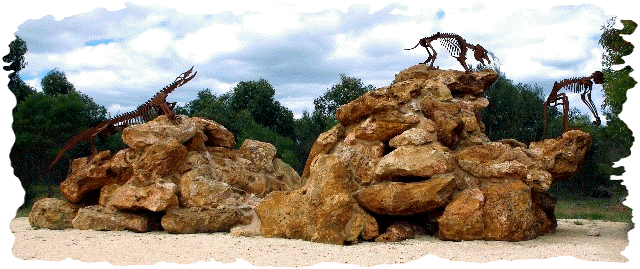
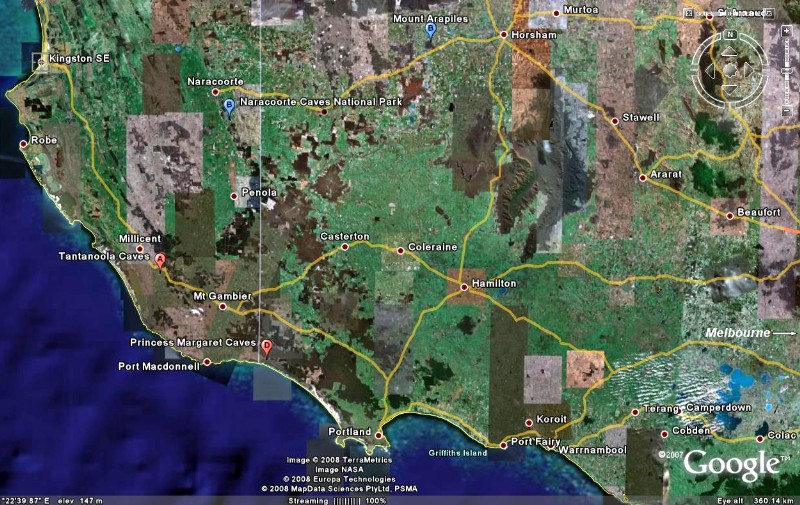
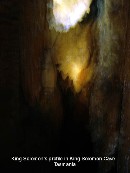 In the Enid Blyton era of my childhood, a cave brought on visions of smugglers gleefully gloating
over their loot or buccaneers yo-ho-ho-ing with their bottle of rum as they surveyed
their ill-gotten treasure or a secret laboratory operated by a mad scientist... As I
grew older, the vision changed to associating a cave as being a cold, dark and
damp place inhabited by bats, creepy crawlies or worse still, things that go
'bump' in the dark! My eyes were finally opened to the wonders of how
beautiful a cave can be when my MOTH took me for a visit to the dolomite
Newdegate Cave (Hastings Cave) in Tasmania in November last year. I
managed to overcome the initial apprehension of leaving the daylight behind me
as I stepped down into the dark, mysterious atmosphere of the cave and am I
ever so glad that I took that first step! The magnificence of the various
speleothems that decorated the cave took my breath away and ever since then, I
can't seem to get enough of them. While in Tasmania, we also took in the limestone
caves of
Marakoopa and
King Solomon at Mole Creek.
In the Enid Blyton era of my childhood, a cave brought on visions of smugglers gleefully gloating
over their loot or buccaneers yo-ho-ho-ing with their bottle of rum as they surveyed
their ill-gotten treasure or a secret laboratory operated by a mad scientist... As I
grew older, the vision changed to associating a cave as being a cold, dark and
damp place inhabited by bats, creepy crawlies or worse still, things that go
'bump' in the dark! My eyes were finally opened to the wonders of how
beautiful a cave can be when my MOTH took me for a visit to the dolomite
Newdegate Cave (Hastings Cave) in Tasmania in November last year. I
managed to overcome the initial apprehension of leaving the daylight behind me
as I stepped down into the dark, mysterious atmosphere of the cave and am I
ever so glad that I took that first step! The magnificence of the various
speleothems that decorated the cave took my breath away and ever since then, I
can't seem to get enough of them. While in Tasmania, we also took in the limestone
caves of
Marakoopa and
King Solomon at Mole Creek.
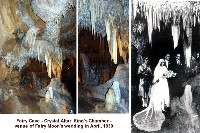 My MOTH surprised me with a new digital SLR camera in July, 2008 (I think it must be
his way of showing his appreciation of my cooking as it couldn't possibly be
for my housekeeping!) and whisked me off for a trip to Buchan in S.E. Victoria
to visit
Fairy Cave with its beautiful limestone formations. Fairy Cave was
discovered in 1907 by a pioneering speleologist Frank Moon, a man with a wicked
sense of humour who was so pleased with his discovery that he named his first
daughter, 'Fairy'. Years later, Fairy fell in love with Frank Hansford, a cave
tour guide and they wanted to marry inside Fairy Cave. They wrote to the authority to ask permission, but the request was denied. But Frank Moon had
the keys to the cave so they went ahead with the wedding at the "Crystal Altar"
in April 1930. Fairy obviously inherited her father's sense of humour as she
named her first son, 'Cave'. [We made a return visit to Buchan in early December to visit
Royal Cave (discovered in 1910
by Frederick Wilson) which was closed for renovations during our first visit.]
My MOTH surprised me with a new digital SLR camera in July, 2008 (I think it must be
his way of showing his appreciation of my cooking as it couldn't possibly be
for my housekeeping!) and whisked me off for a trip to Buchan in S.E. Victoria
to visit
Fairy Cave with its beautiful limestone formations. Fairy Cave was
discovered in 1907 by a pioneering speleologist Frank Moon, a man with a wicked
sense of humour who was so pleased with his discovery that he named his first
daughter, 'Fairy'. Years later, Fairy fell in love with Frank Hansford, a cave
tour guide and they wanted to marry inside Fairy Cave. They wrote to the authority to ask permission, but the request was denied. But Frank Moon had
the keys to the cave so they went ahead with the wedding at the "Crystal Altar"
in April 1930. Fairy obviously inherited her father's sense of humour as she
named her first son, 'Cave'. [We made a return visit to Buchan in early December to visit
Royal Cave (discovered in 1910
by Frederick Wilson) which was closed for renovations during our first visit.]
I received a message from my MOTH while he was at work one day telling me to find
out more about Naracoorte Caves National Park in South Australia, one of
Australia's fourteen World Heritage areas. This national park was added to the
World Heritage List because of extensive fossil deposits found inside the caves
that have revealed so much about Australia's unique marsupial heritage. Later
that same evening, he suggested that we should go on a road-trip to check out the caves.
Ever obedient, I resisted the temptation to decline in favour of my favourite
pastime of doing housework. Yeah, right! In actual fact, I had my suitcase packed
by the time he came home from work the next day. While waiting for the roadtrip
to commence, I cooked up several meals to see us through the week in Just Trip'n
(our motor-home) and threw them into our freezer.

 I woke up with the birds on the day of our departure to re-fry up some curry
puffs I had made the day before to feed our faces during the long drive to
Naracoorte. After loading up Just Trip'n with enough food and clothing to last for at least a month, we were ready to set off. It was an uneventful drive heading
north-west to Horsham, passing sleepy townships, many, many golden fields of
canola, countless vineyards and cattle farms. From Horsham, we headed
south-west and made a detour to check out Mount Arapiles, Victoria's climbing Mecca.
Mount Arapiles offers over 2000 quality climbing routes in one fairly small mountain
of super-strong sandstone.
I woke up with the birds on the day of our departure to re-fry up some curry
puffs I had made the day before to feed our faces during the long drive to
Naracoorte. After loading up Just Trip'n with enough food and clothing to last for at least a month, we were ready to set off. It was an uneventful drive heading
north-west to Horsham, passing sleepy townships, many, many golden fields of
canola, countless vineyards and cattle farms. From Horsham, we headed
south-west and made a detour to check out Mount Arapiles, Victoria's climbing Mecca.
Mount Arapiles offers over 2000 quality climbing routes in one fairly small mountain
of super-strong sandstone.

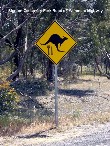 On the way to Mount Arapiles, we passed Declaration Crag, one of the most easily
accessed crags in the country, a mere 15m from the road. Declaration Crag is a big self-contained rock often used by instructors as a beginners' training ground for
rock-climbing enthusiasts with climbs of all grades up to 29. The sight of this
impressive crag naturally got us reaching for our cameras and after several happy
snaps of it, we resumed the drive to the Pines campsite to get photos of Mount
Arapiles before continuing on our journey to Naracoorte.
On the way to Mount Arapiles, we passed Declaration Crag, one of the most easily
accessed crags in the country, a mere 15m from the road. Declaration Crag is a big self-contained rock often used by instructors as a beginners' training ground for
rock-climbing enthusiasts with climbs of all grades up to 29. The sight of this
impressive crag naturally got us reaching for our cameras and after several happy
snaps of it, we resumed the drive to the Pines campsite to get photos of Mount
Arapiles before continuing on our journey to Naracoorte.
 We arrived at the Naracoorte Holiday Park in the late afternoon and as soon as
Just Trip'n was connected to the power source, we went for an unhurried walk
through a nearby park to stretch our legs and watch a few Pilgrim Geese
frolicking in the pond. Dinner that evening consisted of lamb curry and rice
followed by coffee and home-made banana cake. We challenged our eyes with some
TV viewing but my MOTH surrendered to sleep well before midnight. I was too
excited to sleep so I played games on my Nintendo DS before succumbing to
sleep at about 1 am.
We arrived at the Naracoorte Holiday Park in the late afternoon and as soon as
Just Trip'n was connected to the power source, we went for an unhurried walk
through a nearby park to stretch our legs and watch a few Pilgrim Geese
frolicking in the pond. Dinner that evening consisted of lamb curry and rice
followed by coffee and home-made banana cake. We challenged our eyes with some
TV viewing but my MOTH surrendered to sleep well before midnight. I was too
excited to sleep so I played games on my Nintendo DS before succumbing to
sleep at about 1 am.

 Bright and early the next morning saw us on the road to Naracoorte Caves
National Park. Altogether, there are 26 caves in the Naracoorte National Park
although not all are open to the public. Some are set aside for scientific research
and study while some are closed for the preservation of its precious historic contents.
Several caves are open to the public with regular guided tours - from short easy
tours to long more adventurous 'un-developed' cave tours by torchlight (eg. Cathedral Cave).
We opted for the four unit 'easy' cave tours which included free
admission to the Wonambi Fossil Centre walk-through diorama "museum". First on
the
Bright and early the next morning saw us on the road to Naracoorte Caves
National Park. Altogether, there are 26 caves in the Naracoorte National Park
although not all are open to the public. Some are set aside for scientific research
and study while some are closed for the preservation of its precious historic contents.
Several caves are open to the public with regular guided tours - from short easy
tours to long more adventurous 'un-developed' cave tours by torchlight (eg. Cathedral Cave).
We opted for the four unit 'easy' cave tours which included free
admission to the Wonambi Fossil Centre walk-through diorama "museum". First on
the  agenda at 9.30am was a half hour guided tour of
Alexandra Cave, discovered by William Reddan in 1908 and opened to the
public in 1909. The cave was named after the wife of King Edward VII of
England, Queen Alexandra. After going down 25 steps into the cave, we were
treated to awesome views of speleothems formations that decorated the three
chambers and a fascinating "Mirror Pool" before going up 35 steps to exit the
cave.
agenda at 9.30am was a half hour guided tour of
Alexandra Cave, discovered by William Reddan in 1908 and opened to the
public in 1909. The cave was named after the wife of King Edward VII of
England, Queen Alexandra. After going down 25 steps into the cave, we were
treated to awesome views of speleothems formations that decorated the three
chambers and a fascinating "Mirror Pool" before going up 35 steps to exit the
cave.
 As soon as the guided tour was over, it was a mad dash to drive 1.5 km to visit
the Victoria Fossil Cave for the one hour guided tour. This cave was discovered before Alexandra Cave by
William Reddan in 1894 and soon after the discovery, it was
partly developed as a show cave and opened to the public.
As soon as the guided tour was over, it was a mad dash to drive 1.5 km to visit
the Victoria Fossil Cave for the one hour guided tour. This cave was discovered before Alexandra Cave by
William Reddan in 1894 and soon after the discovery, it was
partly developed as a show cave and opened to the public.
130.jpg)
130.jpg) The entrance to Victoria Fossil Cave was last blocked by sediment around 16,000 years ago and
it is estimated to contain about 5000 tonnes of bone and sediment. Major
discoveries of ancient animal bones, notably the 'megafauna' of giant
marsupials were made in 1969 and the subsequent years. Six fossil deposits are now known to
be in
this cave and in 1994 the park was inscribed in the World Heritage List. We descended 30 steps into
a chamber beautifully decorated with speleothems before winding our way through 250 metres of passages and
chambers to a large fossil deposit chamber. We spent about half an hour in this
fossil chamber that has a dig site and two re-constructed fossil skeletons -
'Leo', the Marsupial Lion (Thylacoleo carnifex) and 'Stanley', the extinct
leaf-eating kangaroo (Simosthenurus occidentalis). After an interesting talk on
the world heritage values of the cave, we exited through a 150 metre sloping
passage to be greeted by sunshine. The entrance to Victoria Fossil Cave was last blocked by sediment around 16,000 years ago and
it is estimated to contain about 5000 tonnes of bone and sediment. Major
discoveries of ancient animal bones, notably the 'megafauna' of giant
marsupials were made in 1969 and the subsequent years. Six fossil deposits are now known to
be in
this cave and in 1994 the park was inscribed in the World Heritage List. We descended 30 steps into
a chamber beautifully decorated with speleothems before winding our way through 250 metres of passages and
chambers to a large fossil deposit chamber. We spent about half an hour in this
fossil chamber that has a dig site and two re-constructed fossil skeletons -
'Leo', the Marsupial Lion (Thylacoleo carnifex) and 'Stanley', the extinct
leaf-eating kangaroo (Simosthenurus occidentalis). After an interesting talk on
the world heritage values of the cave, we exited through a 150 metre sloping
passage to be greeted by sunshine.
 We ignored our tummies which were beginning to growl for lunch and hastily drove back to the
Wonambi Fossil Centre to take in the Bat 'tour' which commenced as soon as all the visitors
were accounted for.
We ignored our tummies which were beginning to growl for lunch and hastily drove back to the
Wonambi Fossil Centre to take in the Bat 'tour' which commenced as soon as all the visitors
were accounted for. 
 The tour group headed by our tour guide then made a bee-line for the Bat
Observation Centre, a few minutes' walk away. I was sort of half-expecting an up close and
personal look at the Southern Bentwing bats (Miniopterus schreibersii bassanii) which would
have been rather exciting (despite the foul odour of bats' urine) so I was a tad disappointed
at what we got to see. As we entered the Observation Centre, we were asked to be seated around
a row of monitors showing behind-the-scene views of how bats live in their natural habitat via
infra-red cameras installed in various chambers of the 300 metres long bat cave. We were given
the opportunity to examine a box of bats specimens and marvel at how small, soft and furry the
little critters felt to the touch.
The tour group headed by our tour guide then made a bee-line for the Bat
Observation Centre, a few minutes' walk away. I was sort of half-expecting an up close and
personal look at the Southern Bentwing bats (Miniopterus schreibersii bassanii) which would
have been rather exciting (despite the foul odour of bats' urine) so I was a tad disappointed
at what we got to see. As we entered the Observation Centre, we were asked to be seated around
a row of monitors showing behind-the-scene views of how bats live in their natural habitat via
infra-red cameras installed in various chambers of the 300 metres long bat cave. We were given
the opportunity to examine a box of bats specimens and marvel at how small, soft and furry the
little critters felt to the touch.
 After the Bat Observation Centre and as part of the one hour Bat Centre tour we followed our guide to
Blanche Cave
where Bentwing bats can be seen at certain times of the year. Unfortunately, we didn't see any, as the
action begins at dusk each night in the summer when the bats start their warm-up laps around
the Blanche Cave chambers before they make their way outside in search of their food of insects.
The first cave in the Naracoorte National Park to be discovered, Blanche Cave was found by a group
of local settlers who were trying to recover some sheep which had been stolen by local Aborigines.
Back then, Blanche Cave was known as the Big Cave. In 1859, Pleistocene (from two million to 11
thousand years ago) fossil bones were found in the cave by the Rev. Tenison-Woods who believed he
had found evidence of the 'biblical flood' in Australia.
After the Bat Observation Centre and as part of the one hour Bat Centre tour we followed our guide to
Blanche Cave
where Bentwing bats can be seen at certain times of the year. Unfortunately, we didn't see any, as the
action begins at dusk each night in the summer when the bats start their warm-up laps around
the Blanche Cave chambers before they make their way outside in search of their food of insects.
The first cave in the Naracoorte National Park to be discovered, Blanche Cave was found by a group
of local settlers who were trying to recover some sheep which had been stolen by local Aborigines.
Back then, Blanche Cave was known as the Big Cave. In 1859, Pleistocene (from two million to 11
thousand years ago) fossil bones were found in the cave by the Rev. Tenison-Woods who believed he
had found evidence of the 'biblical flood' in Australia.
 The site where the bones were found became a popular venue for picnics and various social functions
and up till the 1960s, caves such as Blanche Cave were visited more for the decorations of their
stalactites and stalagmites than for their precious scientific importance. In recent times, occasional
special events such as "Carols by Cavelight" are held in the first chamber. On July 18th 2000, the
Olympic Torch Flame was passed from torch to torch to a backdrop of 1,500 tea-light candles in the same
chamber. That must have been an awesome sight indeed! We walked about 400 metres through the cave's
three enormous chambers, with daylight streaming in via three large roof collapse 'windows', awestruck
at the sight of gigantic columns and stalagmites that fill the chambers.
The site where the bones were found became a popular venue for picnics and various social functions
and up till the 1960s, caves such as Blanche Cave were visited more for the decorations of their
stalactites and stalagmites than for their precious scientific importance. In recent times, occasional
special events such as "Carols by Cavelight" are held in the first chamber. On July 18th 2000, the
Olympic Torch Flame was passed from torch to torch to a backdrop of 1,500 tea-light candles in the same
chamber. That must have been an awesome sight indeed! We walked about 400 metres through the cave's
three enormous chambers, with daylight streaming in via three large roof collapse 'windows', awestruck
at the sight of gigantic columns and stalagmites that fill the chambers.

 After the conclusion of the Blanche Cave tour, there was no longer any need to race around as we were free to explore the Wet Cave and the Wonambi Fossil Centre walk-through diorama at our leisure. We decided to starve our belly worms and went to check out the Wet Cave while the other visitors were at lunch, in order to avoid a crowd. Wet Cave has two large collapsed 'window' entrances - we descended into the first chamber with its enormous limestone formations via a metal stairway down one of the entrances. Many of the formations are green in colour due to the effects of Cyanobacteria (blue-green algae) which thrives in the damp climate and natural light - so green that I was almost fooled into thinking we had wandered into a jade cave! We also noticed that the natural light coming through the entrances made it possible for some healthy looking tree ferns to grow. Following the marked trail led us into a large dome chamber with the lower part of the cave having a flat roof with many avens (cylindrical holes formed when water dissolved into limestone). I believe animals such as opossums, bats and birds inhabit the dark interior of this cave, especially during winter. Wet Cave is also used for adventure tours where visitors go beyond the regular tour path and into the darkness of Stick-Tomato Cave. They squeeze and crawl through passages in the cave, eventually coming out beneath the second collapse window. By the time we finished our half-hour self-guided tour, other visitors were beginning to trickle in so it looked like we had our tour timed to perfection.
After the conclusion of the Blanche Cave tour, there was no longer any need to race around as we were free to explore the Wet Cave and the Wonambi Fossil Centre walk-through diorama at our leisure. We decided to starve our belly worms and went to check out the Wet Cave while the other visitors were at lunch, in order to avoid a crowd. Wet Cave has two large collapsed 'window' entrances - we descended into the first chamber with its enormous limestone formations via a metal stairway down one of the entrances. Many of the formations are green in colour due to the effects of Cyanobacteria (blue-green algae) which thrives in the damp climate and natural light - so green that I was almost fooled into thinking we had wandered into a jade cave! We also noticed that the natural light coming through the entrances made it possible for some healthy looking tree ferns to grow. Following the marked trail led us into a large dome chamber with the lower part of the cave having a flat roof with many avens (cylindrical holes formed when water dissolved into limestone). I believe animals such as opossums, bats and birds inhabit the dark interior of this cave, especially during winter. Wet Cave is also used for adventure tours where visitors go beyond the regular tour path and into the darkness of Stick-Tomato Cave. They squeeze and crawl through passages in the cave, eventually coming out beneath the second collapse window. By the time we finished our half-hour self-guided tour, other visitors were beginning to trickle in so it looked like we had our tour timed to perfection.
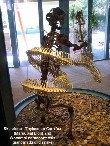
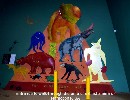 From Wet Cave, we headed back to the Wonambi Fossil Centre to view the model of the skeletons in the foyer titled "Life's Struggle" which shows the Marsupial Lion (Thylacoleo Carnifex) wrestling with the giant madtsoiid snake (Wonambi naracoortensis). These two animals are symbolic of the many extinct species found at Naracoorte. Wonambi is the Aboriginal Rainbow Serpent of the Dreamtime. The name has been used for the large snake first described from fossil remains at the Naracoorte Caves and after which the centre is named. Thylacoleo is derived from the Latin terms thylacis meaning pouched and leo meaning lion. This animal was Australia's largest predatory mammal. Fossil remains of this animal are relatively common throughout the Naracoorte Caves. [Excerpt from information plaque.]
From Wet Cave, we headed back to the Wonambi Fossil Centre to view the model of the skeletons in the foyer titled "Life's Struggle" which shows the Marsupial Lion (Thylacoleo Carnifex) wrestling with the giant madtsoiid snake (Wonambi naracoortensis). These two animals are symbolic of the many extinct species found at Naracoorte. Wonambi is the Aboriginal Rainbow Serpent of the Dreamtime. The name has been used for the large snake first described from fossil remains at the Naracoorte Caves and after which the centre is named. Thylacoleo is derived from the Latin terms thylacis meaning pouched and leo meaning lion. This animal was Australia's largest predatory mammal. Fossil remains of this animal are relatively common throughout the Naracoorte Caves. [Excerpt from information plaque.]
  We then stepped back in time in the walk-through diorama "museum" filled with animated life-sized models of extinct Australian animals in their re-constructed We then stepped back in time in the walk-through diorama "museum" filled with animated life-sized models of extinct Australian animals in their re-constructed  natural habitat of over 200,000 years ago. What an interesting tour that was as we also got to view the skeletal remains of extinct reptiles, birds and mammals that existed in the Naracoorte region all those years ago. We exited the diorama "museum" and went around checking the courtyard where we saw the "Nest Robber" display. Before our final exit, we went for a stroll around the Information Centre garden and took a few photos of some of the flowering shrubs they had growing there. All in all, it has been a great tour which we both thoroughly enjoyed. natural habitat of over 200,000 years ago. What an interesting tour that was as we also got to view the skeletal remains of extinct reptiles, birds and mammals that existed in the Naracoorte region all those years ago. We exited the diorama "museum" and went around checking the courtyard where we saw the "Nest Robber" display. Before our final exit, we went for a stroll around the Information Centre garden and took a few photos of some of the flowering shrubs they had growing there. All in all, it has been a great tour which we both thoroughly enjoyed.
130.jpg) 130.jpg) 130.jpg) 130.jpg) 130.jpg) 130.jpg) 130.jpg) 
Leaving Naracoorte Caves behind us, we drove on to Kingston SE to spend the night. The old coastal town of Kingston SE, "Gateway to the South East", famous for its lobsters, is approximately 297km/185ml south-east of Adelaide, the capital of South Australia. 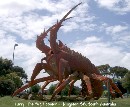 Kingston SE with a population of about 1500 is not to be confused with Kingston on the Murray River. Originally called Maria Creek after a ship wrecked in the bay, it was given its present name in 1840, after a government surveyor, George Strickland Kingston. It is a paradise for anglers and lobster lovers with a fleet of about 40 lobster boats operating from the port during the fresh lobster season from October to April. Kingston SE has the 18.2mt/60ft high fibreglass "Larry", the Big Lobster, as its dominant landmark. The town's main industries are fishing, wine-making, sheep and cattle farming. Kingston SE with a population of about 1500 is not to be confused with Kingston on the Murray River. Originally called Maria Creek after a ship wrecked in the bay, it was given its present name in 1840, after a government surveyor, George Strickland Kingston. It is a paradise for anglers and lobster lovers with a fleet of about 40 lobster boats operating from the port during the fresh lobster season from October to April. Kingston SE has the 18.2mt/60ft high fibreglass "Larry", the Big Lobster, as its dominant landmark. The town's main industries are fishing, wine-making, sheep and cattle farming.  We left Kingston SE the next morning and travelled along the Princes Highway - destination: Tantanoola Cave! But first, my MOTH stopped at Downs Lookout in the coastal town of Robe just so I could put my camera to work by snapping up photos of wildflowers growing in
profusion on the hillside and sand dunes. It was rather windy that day, so a lot of patience was required to get nice close-up shots in the all too brief intervals between the wind gusts. I could tell by my MOTH's body language that he would like to get home by Christmas so about 5 or 6 dozens clicks later, I decided it would be in my best interest to get back into Just Trip'n and continue on our way, as I didn't fancy being left behind... We left Kingston SE the next morning and travelled along the Princes Highway - destination: Tantanoola Cave! But first, my MOTH stopped at Downs Lookout in the coastal town of Robe just so I could put my camera to work by snapping up photos of wildflowers growing in
profusion on the hillside and sand dunes. It was rather windy that day, so a lot of patience was required to get nice close-up shots in the all too brief intervals between the wind gusts. I could tell by my MOTH's body language that he would like to get home by Christmas so about 5 or 6 dozens clicks later, I decided it would be in my best interest to get back into Just Trip'n and continue on our way, as I didn't fancy being left behind...
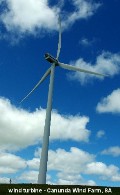 We drove along until we reached the rural township of Millicent. [Situated 50km from Mount Gambier, Millicent was surveyed
We drove along until we reached the rural township of Millicent. [Situated 50km from Mount Gambier, Millicent was surveyed  in 1870 and built on land previously owned by Mayurra Station. It was named after Millicent Short, the daughter of the first Anglican Archbishop of Adelaide.] Nothing of interest to us in Millicent so we travelled on... There we were, driving along, singing a song, when what should catch our eyes but lots and lots of wind turbines. The sign indicated that we were approaching the Canunda Wind Farm so the MOTH decided we should make a slight detour to have a bit of a sticky-beak at this wind power project. in 1870 and built on land previously owned by Mayurra Station. It was named after Millicent Short, the daughter of the first Anglican Archbishop of Adelaide.] Nothing of interest to us in Millicent so we travelled on... There we were, driving along, singing a song, when what should catch our eyes but lots and lots of wind turbines. The sign indicated that we were approaching the Canunda Wind Farm so the MOTH decided we should make a slight detour to have a bit of a sticky-beak at this wind power project.  Formerly named Lake Bonney Central Wind Farm, the Canunda Wind Farm at Stage 1 is made up of 23 wind turbines, each turbine is a 67m/220ft high tower with three 40m/130ft long blades (total of 107m/351ft high to the tip of the blade). This $92.5 million wind power project located on grazing land approximately 16 kilometres south of Millicent was opened by the Premier of South Australia, Mike Rann on March 31st, 2005. Work in Stage 2 began in Nov 2006 and finished in April 2008 with the addition of 53 wind turbines, (each 78m/256ft steel tower has a 90m/295ft rotor diameter and 44m/144ft blade length). The 16km (almost 10 miles) long Wind Farm distribution line transports the generated electricity to a nearby substation at Snuggery. Formerly named Lake Bonney Central Wind Farm, the Canunda Wind Farm at Stage 1 is made up of 23 wind turbines, each turbine is a 67m/220ft high tower with three 40m/130ft long blades (total of 107m/351ft high to the tip of the blade). This $92.5 million wind power project located on grazing land approximately 16 kilometres south of Millicent was opened by the Premier of South Australia, Mike Rann on March 31st, 2005. Work in Stage 2 began in Nov 2006 and finished in April 2008 with the addition of 53 wind turbines, (each 78m/256ft steel tower has a 90m/295ft rotor diameter and 44m/144ft blade length). The 16km (almost 10 miles) long Wind Farm distribution line transports the generated electricity to a nearby substation at Snuggery.

 Several photos later, we jumped back into Just Trip'n, got back on the Princes Highway and continued on to check out Tantanoola Cave. Tantanoola Cave, named after a nearby town where its discoverer hailed from, is located between Millicent and Mount Gambier. The first person to discover the cave was no speleologist or cave expert but a Tantanoola lad named Boyce Lane who was out hunting rabbits with his pet ferret. His ferret wandered off so he waited patiently for its return, got impatient and so decided to investigate by moving some rocks. He found the beautiful cave on Mar 28, 1930.
Several photos later, we jumped back into Just Trip'n, got back on the Princes Highway and continued on to check out Tantanoola Cave. Tantanoola Cave, named after a nearby town where its discoverer hailed from, is located between Millicent and Mount Gambier. The first person to discover the cave was no speleologist or cave expert but a Tantanoola lad named Boyce Lane who was out hunting rabbits with his pet ferret. His ferret wandered off so he waited patiently for its return, got impatient and so decided to investigate by moving some rocks. He found the beautiful cave on Mar 28, 1930.  It is a single-chamber dolomite cave about 30m across and 8m high, located inside 'Up and Down Rocks', an ancient coastal cliff. It is a single-chamber dolomite cave about 30m across and 8m high, located inside 'Up and Down Rocks', an ancient coastal cliff.  The cave is notable for its spectacular cave decorations and reflection pool. The entrance of the cave was lowered in 1983 during renovations to make it Australia's first wheelchair access cave. We were delighted when told by the guide that we could stay behind and take photos to our hearts' content as the tours are not time-limited. Two million photos later, we exited the cave and followed the steps leading up to a walking track along the top of Up and Down Rocks which offered spectacular views of the surrounds. In the horizon we could see the wind turbines of the Canunda Wind Farm. I gave Tantanoola Cave full marks as being the most beautiful cave I've seen so far. The cave is notable for its spectacular cave decorations and reflection pool. The entrance of the cave was lowered in 1983 during renovations to make it Australia's first wheelchair access cave. We were delighted when told by the guide that we could stay behind and take photos to our hearts' content as the tours are not time-limited. Two million photos later, we exited the cave and followed the steps leading up to a walking track along the top of Up and Down Rocks which offered spectacular views of the surrounds. In the horizon we could see the wind turbines of the Canunda Wind Farm. I gave Tantanoola Cave full marks as being the most beautiful cave I've seen so far.

 We left Tantanoola Cave and headed for Mount Gambier to spend the night at a caravan park there before an early morning departure to get to Princess Margaret Rose Cave which is located 30 minutes from Mount Gambier, 2km east of the SA/VIC border, on the Victorian side. Princess Margaret Rose Cave was formed when the Glenelg River flowed 15m above its present level. In 1936, grazier Keith McEarchern lowered himself 17.5m/57.4ft by rope down a shaft he discovered on his property and discovered the stream-passage cave with its beautiful speleothems.
We left Tantanoola Cave and headed for Mount Gambier to spend the night at a caravan park there before an early morning departure to get to Princess Margaret Rose Cave which is located 30 minutes from Mount Gambier, 2km east of the SA/VIC border, on the Victorian side. Princess Margaret Rose Cave was formed when the Glenelg River flowed 15m above its present level. In 1936, grazier Keith McEarchern lowered himself 17.5m/57.4ft by rope down a shaft he discovered on his property and discovered the stream-passage cave with its beautiful speleothems.  He explored and built an entrance, carved some steps in the limestone into the cave which he named in honour of He explored and built an entrance, carved some steps in the limestone into the cave which he named in honour of 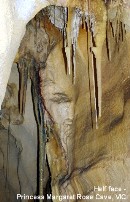 Princess Margaret (1930-2002), (younger sister of Queen Elizabeth II) and began charging for guided tours from January 4th 1941. The present day entrance was dug through the soft limestone as the original entrance was incredibly steep (notches are still visible in the sides of the cave where the timbers for the stairs were located). We followed our guide down 82 steep, slippery steps to begin the 40min tour. We saw excellent examples of actively growing stalagmites, stalactites, gravity-defying helictites, straws, shawls and the rarely seen "cave coral". Princess Margaret (1930-2002), (younger sister of Queen Elizabeth II) and began charging for guided tours from January 4th 1941. The present day entrance was dug through the soft limestone as the original entrance was incredibly steep (notches are still visible in the sides of the cave where the timbers for the stairs were located). We followed our guide down 82 steep, slippery steps to begin the 40min tour. We saw excellent examples of actively growing stalagmites, stalactites, gravity-defying helictites, straws, shawls and the rarely seen "cave coral".  I was fascinated by a freaky half face (to me it looked a bit like Christopher Lee as Count Dracula) which seemed to be sneaking a peek at us as he hid behind the speleothems... The tour goes as far as the final but unsuccessful dig. In 1980, the cave became part of the Lower Glenelg National Park. After the cave tour ended, we went for a nature walk following the trail from the Information Centre to take in views of the Glenelg River and gorge and I also managed to snap a few photos of some native ground orchids and other flora. We continued walking until we emerged near the car-park and after a brunch of tuna sandwiches, my MOTH cranked up the engine of Just Trip'n and hit the road to get to our next destination - Port Fairy. I was fascinated by a freaky half face (to me it looked a bit like Christopher Lee as Count Dracula) which seemed to be sneaking a peek at us as he hid behind the speleothems... The tour goes as far as the final but unsuccessful dig. In 1980, the cave became part of the Lower Glenelg National Park. After the cave tour ended, we went for a nature walk following the trail from the Information Centre to take in views of the Glenelg River and gorge and I also managed to snap a few photos of some native ground orchids and other flora. We continued walking until we emerged near the car-park and after a brunch of tuna sandwiches, my MOTH cranked up the engine of Just Trip'n and hit the road to get to our next destination - Port Fairy.


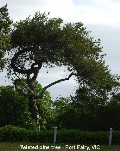 We arrived at the Gardens By East Beach Caravan Park just after noon and as soon as we finished plugging in Just Trip'n to the power source, we grabbed our cameras and went for a leisurely stroll across the bridge over the Moyne River to get a feed of delicious cooked-to-order fish and chips. What an enjoyable lunch we had, sitting on the bench by the riverside watching the greedy sea-gulls fighting over the chips thrown out by the other tourists. After appeasing the worms in our bellies, we sauntered back across the bridge for a walk in the Port Fairy Botanic Gardens which adjoins the caravan park we were in.
We arrived at the Gardens By East Beach Caravan Park just after noon and as soon as we finished plugging in Just Trip'n to the power source, we grabbed our cameras and went for a leisurely stroll across the bridge over the Moyne River to get a feed of delicious cooked-to-order fish and chips. What an enjoyable lunch we had, sitting on the bench by the riverside watching the greedy sea-gulls fighting over the chips thrown out by the other tourists. After appeasing the worms in our bellies, we sauntered back across the bridge for a walk in the Port Fairy Botanic Gardens which adjoins the caravan park we were in.  How delighted was I to notice an abundance of our feathered friends merrily flying around amongst the trees and shrubs searching for their afternoon tea. Naturally, our fingers began working overtime on the click buttons of our respective cameras! Having taken our fill of bird photos, we went back to Just Trip'n and completed our evening ritual before finishing off the last of our frozen meals from home for dinner that night. How delighted was I to notice an abundance of our feathered friends merrily flying around amongst the trees and shrubs searching for their afternoon tea. Naturally, our fingers began working overtime on the click buttons of our respective cameras! Having taken our fill of bird photos, we went back to Just Trip'n and completed our evening ritual before finishing off the last of our frozen meals from home for dinner that night.
All good things must come to an end so the next morning, we pulled the plug from the power source and hit the road to head for home. It has been another great trip we will long remember and we left after promising ourselves we will be back to re-visit
Tantanoola Cave... next time, armed with a tripod!
[Please click on the link for each cave to view more photos.]
OzLadyM
 

Border: BoogieJack
Smilies: Smiliemania
Copyright � 2009
OzLadyM
Please do not use any material on this website without my permission. Thank
you.
|

130.jpg)
130.jpg)
130.jpg)
130.jpg)
130.jpg)
130.jpg)
130.jpg)



 We arrived at the Gardens By East Beach Caravan Park just after noon and as soon as we finished plugging in Just Trip'n to the power source, we grabbed our cameras and went for a leisurely stroll across the bridge over the Moyne River to get a feed of delicious cooked-to-order fish and chips. What an enjoyable lunch we had, sitting on the bench by the riverside watching the greedy sea-gulls fighting over the chips thrown out by the other tourists. After appeasing the worms in our bellies, we sauntered back across the bridge for a walk in the Port Fairy Botanic Gardens which adjoins the caravan park we were in.
We arrived at the Gardens By East Beach Caravan Park just after noon and as soon as we finished plugging in Just Trip'n to the power source, we grabbed our cameras and went for a leisurely stroll across the bridge over the Moyne River to get a feed of delicious cooked-to-order fish and chips. What an enjoyable lunch we had, sitting on the bench by the riverside watching the greedy sea-gulls fighting over the chips thrown out by the other tourists. After appeasing the worms in our bellies, we sauntered back across the bridge for a walk in the Port Fairy Botanic Gardens which adjoins the caravan park we were in.  How delighted was I to notice an abundance of our feathered friends merrily flying around amongst the trees and shrubs searching for their afternoon tea. Naturally, our fingers began working overtime on the click buttons of our respective cameras! Having taken our fill of bird photos, we went back to Just Trip'n and completed our evening ritual before finishing off the last of our frozen meals from home for dinner that night.
How delighted was I to notice an abundance of our feathered friends merrily flying around amongst the trees and shrubs searching for their afternoon tea. Naturally, our fingers began working overtime on the click buttons of our respective cameras! Having taken our fill of bird photos, we went back to Just Trip'n and completed our evening ritual before finishing off the last of our frozen meals from home for dinner that night.












130.jpg)
130.jpg)




























